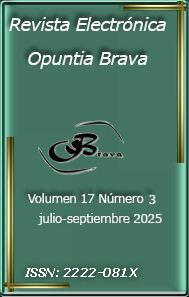Uso de nanopartículas poliméricas para guiar y concentrar fármacos contra el Parkinson
Palabras clave:
: Trastornos de aprendizaje, Inclusión educativa, Alianzas estratégicas, Formación docente, Colaboración interdisciplinaria.Resumen
La enfermedad de Parkinson es considerada a nivel mundial como la más devastadora luego del Alzheimer. Se caracteriza por la destrucción progresiva de las neuronas dopaminérgicas a nivel del sistema nervioso central. Afecta a aproximadamente el 2% de la población general. Se pueden distinguir síntomas motores y no motores según el grado de degeneración neuronal. La principal función de la barrera hematoencefálica es el transporte seleccionado de sustancias al interior. Se distingue además por el acúmulo anormal de α-sinucleína que genera muerte neuronal. Se ha realizado esta recopilación de información basada en bibliografía actualizada y con base científica en artículos publicados en revistas científicas médicas con el fin de informar las actualizaciones de tratamientos innovadores para esta enfermedad, ya que los existentes son netamente paliativos. Se concluye que el uso de nanopartículas poliméricas es un sistema que se encuentra en estudios clínicos, pero los resultados son satisfactorios, prometedores y reducen en gran medida los efectos adversos; se recomienda el ácido poliláctico-co-glicólico para fabricar nanocápsulas incorporando quitosano y crear nanoesferas que ofrezcan una liberación sostenida de fármacos y faciliten el cruce de la BHE.
Descargas
Citas
Alabrahim, O. A. A. & Azzazy, H. M. E. S. (2022). Polymeric nanoparticles for dopamine and levodopa replacement in Parkinson’s disease. Nanoscale Advances, 4(24), 5233–5244. Royal Society of Chemistry. https://doi.org/10.1039/d2na00524g
Alimohammadi, E., Khedri, M., Jahromi, A. M., Maleki, R., & Rezaian, M. (2020). Graphene-based nanoparticles as potential treatment options for parkinson’s disease: A molecular dynamics study. International Journal of Nanomedicine, 15, 6887–6903. https://doi.org/10.2147/IJN.S265140
Annu, A., Qamar, Z., Md, S., Alhakamy, N. A., Baboota, S., & Ali, J. (2022). An Insight to Brain Targeting Utilizing Polymeric Nanoparticles: Effective Treatment Modalities for Neurological Disorders and Brain Tumor. Frontiers in Bioengineering and Biotechnology, 10. Frontiers Media S.A. https://doi.org/10.3389/fbioe.2022.788128
Baskin, J., Jeon, J. E., & Lewis, S. J. G. (2021). Nanoparticles for drug delivery in Parkinson’s disease. Journal of Neurology, 268(5), 1981–1994. https://doi.org/10.1007/s00415-020-10291-x
Cai, H., Liu, D., Xue, W. W., Ma, L., Xie, H. T., & Ning, K. (2024). Lipid-based nanoparticles for drug delivery in Parkinson’s disease. In Translational Neuroscience, 15(1). Walter de Gruyter GmbH. https://doi.org/10.1515/tnsci-2022-0359
Castellani, S., Iaconisi, G. N., Tripaldi, F., Porcelli, V., Trapani, A., Messina, E., Guerra, L., Di Franco, C., Maruccio, G., Monteduro, A. G.,
Corbo, F., Di Gioia, S., Trapani, G., & Conese, M. (2024). Dopamine and Citicoline-Co-Loaded Solid Lipid Nanoparticles as Multifunctional Nanomedicines for Parkinson’s Disease Treatment by Intranasal Administration. Pharmaceutics, 16(8). https://doi.org/10.3390/pharmaceutics16081048
Cometa, S., Bonifacio, M. A., Trapani, G., Di Gioia, S., Dazzi, L., De Giglio, E., & Trapani, A. (2020). In vitro investigations on dopamine loaded Solid Lipid Nanoparticles. Journal of Pharmaceutical and Biomedical Analysis, 185. https://doi.org/10.1016/j.jpba.2020.113257
Fracp, V., Morris, H. R., Foltynie, T., Foltynie, T., Vijiaratnam, N., Simuni, T., Bandmann, O., & Morris, H. R. (2021). Progress towards therapies for disease modification in Parkinson’s disease. Review Lancet Neurol, 20. https://www.thelancet.com/journals/laneur/article/PIIS1474-4422(21)00061-2/abstract
Gao, C., Liu, J., Tan, Y., & Chen, S. (2020). Freezing of gait in Parkinson’s disease: Pathophysiology, risk factors and treatments. Translational Neurodegeneration, 9 (1). BioMed Central Ltd. https://doi.org/10.1186/s40035-020-00191-5
García-Pardo, J., Novio, F., Nador, F., Cavaliere, I., Suárez-García, S., Lope-Piedrafita, S., Candiota, A. P., Romero-Gimenez, J., Rodríguez-
Galván, B., Bové, J., Vila, M., Lorenzo, J., & Ruiz-Molina, D. (2021). Bioinspired theranostic coordination polymer nanoparticles for intranasal dopamine replacement in parkinson’s disease. ACS Nano, 15(5), 8592–8609. https://doi.org/10.1021/acsnano.1c00453
Han, L. & Jiang, C. (2021). Evolution of blood–brain barrier in brain diseases and related systemic nanoscale brain-targeting drug delivery strategies. In Acta Pharmaceutica Sinica B, 11(8), 2306–2325. Chinese Academy of Medical Sciences. https://doi.org/10.1016/j.apsb.2020.11.023
Hernández-Parra, H., Cortés, H., Avalos-Fuentes, J. A., Del Prado-Audelo, M., Florán, B., Leyva-Gómez, G., Sharifi-Rad, J., & Cho, W. C. (2022). Repositioning of drugs for Parkinson’s disease and pharmaceutical nanotechnology tools for their optimization. Journal of Nanobiotechnology, 20(1). BioMed Central Ltd. https://doi.org/10.1186/s12951-022-01612-5
Jagaran, K., & Singh, M. (2022). Lipid Nanoparticles: Promising Treatment Approach for Parkinson’s Disease. In International Journal of Molecular Sciences, 23(16). MDPI. https://doi.org/10.3390/ijms23169361
Jankovic, J. & Tan, E. K. (2020). Parkinson’s disease: Etiopathogenesis and treatment. Journal of Neurology, Neurosurgery and Psychiatry, 91(8), 795–808. https://doi.org/10.1136/jnnp-2019-322338
Kim, M. & Bezprozvanny, I. (2023). Potential direct role of synuclein in dopamine transport and its implications for Parkinson’s disease pathogenesis. Biochemical and Biophysical Research Communications, 671, 18–25. https://doi.org/10.1016/j.bbrc.2023.05.110
Liu, H., Hua, M., Zheng, Q., Gao, Y., & Li, Z. (2023). Targeting the pathogenesis and boosting the therapeutic efficacy of Parkinson’s disease by advanced nanoparticles. MedComm - Biomaterials and Applications, 2(2). John Wiley and Sons Inc. https://doi.org/10.1002/mba2.47
Lombardo, S. M., Schneider, M., Türeli, A. E., & Türeli, N. G. (2020). Key for crossing the BBB with nanoparticles: The rational design. Beilstein Journal of Nanotechnology, 11, 866–883. Beilstein-Institut Zur Forderung der Chemischen Wissenschaften. https://doi.org/10.3762/BJNANO.11.72
Mogharbel, B. F., Cardoso, M. A., Irioda, A. C., Stricker, P. E. F., Slompo, R. C., Appel, J. M., de Oliveira, N. B., Perussolo, M. C., Saçaki, C. S., da Rosa, N. N., Dziedzic, D. S. M., Travelet, C., Halila, S., Borsali, R., & de Carvalho, K. A. T. (2022). Biodegradable Nanoparticles Loaded with Levodopa and Curcumin for Treatment of Parkinson’s Disease. Molecules, 27(9). https://doi.org/10.3390/molecules27092811
Nakmode, D. D., Day, C. M., Song, Y., & Garg, S. (2023). The Management of Parkinson’s Disease: An Overview of the Current Advancements in Drug Delivery Systems. Pharmaceutics, 15(5). MDPI. https://doi.org/10.3390/pharmaceutics15051503
Paccione, N., Rahmani, M., Barcia, E. & Negro, S. (2022). farmacia Agentes antiparkinsonianos en micro y nanosistemas poliméricos en investigación. https://doi.org/10.3390/farmaceutics15010013
Padilla-Godínez, F. J., Martínez-Becerril, H. A. & Guerra Crespo, M. (2023). ¿Qué hay de nuevo en la búsqueda para tratar la enfermedad de Parkinson? Revista Digital Universitaria, 24(4). https://doi.org/10.22201/cuaieed.16076079e.2023.24.4.12
Pardridge, W. M. (2023). Treatment of Parkinson’s disease with biologics that penetrate the blood–brain barrier via receptor-mediated transport. Frontiers in Aging Neuroscience, 15. Frontiers Media SA. https://doi.org/10.3389/fnagi.2023.1276376
Satapathy, M. K., Yen, T. L., Jan, J. S., Tang, R. D., Wang, J. Y., Taliyan, R., & Yang, C. H. (2021). Solid lipid nanoparticles (Slns): An advanced drug delivery system targeting brain through bbb. Pharmaceutics, 13(8). MDPI AG. https://doi.org/10.3390/pharmaceutics13081183
Van Vliet, E. F., Knol, M. J., Schiffelers, R. M., Caiazzo, M. & Fens, M. H. A. M. (2023). Levodopa-loaded nanoparticles for the treatment of Parkinson’s disease. Journal of Controlled Release, 360, 212–224. https://doi.org/10.1016/j.jconrel.2023.06.026
Wu, X., Yuan, R., Xu, Y., Wang, K., Yuan, H., Meng, T., & Hu, F. (2024). Functionalized lipid nanoparticles modulate the blood-brain barrier and eliminate α-synuclein to repair dopamine neurons. Asian Journal of Pharmaceutical Sciences, 19(2). https://doi.org/10.1016/j.ajps.2024.100904
Yadav, V. K., Dhanasekaran, S., Choudhary, N., Nathiya, D., Thakur, V., Gupta, R., Pramanik, S., Kumar, P., Gupta, N., & Patel, A. (2025). Recent advances in nanotechnology for Parkinson’s disease: diagnosis, treatment, and future perspectives. Frontiers in Medicine, 12. Frontiers Media SA. https://doi.org/10.3389/fmed.2025.1535682
Zhao, N., Yang, Y., Zhang, L., Zhang, Q., Balbuena, L., Ungvari, G. S., Zang, Y. F., & Xiang, Y. T. (2021). Quality of life in Parkinson’s disease: A systematic review and meta-analysis of comparative studies. In CNS Neuroscience and Therapeutics, 27(3), 270–279. Blackwell Publishing Ltd. https://doi.org/10.1111/cns.13549
Zhao, Y., Xiong, S., Liu, P., Liu, W., Wang, Q., Liu, Y., Tan, H., Chen, X., Shi, X., Wang, Q., & Chen, T. (2020). Polymeric nanoparticles-based brain delivery with improved therapeutic efficacy of ginkgolide b in parkinson’s disease. International Journal of Nanomedicine, 15, 10453–10467. https://doi.org/10.2147/IJN.S272831
Zhu, F. D., Hu, Y. J., Yu, L., Zhou, X. G., Wu, J. M., Tang, Y., Qin, D. L., Fan, Q. Z., & Wu, A. G. (2021). Nanoparticles: A Hope for the Treatment of Inflammation in CNS. In Frontiers in Pharmacology, 12. Frontiers Media S.A. https://doi.org/10.3389/fphar.2021.683935



































































